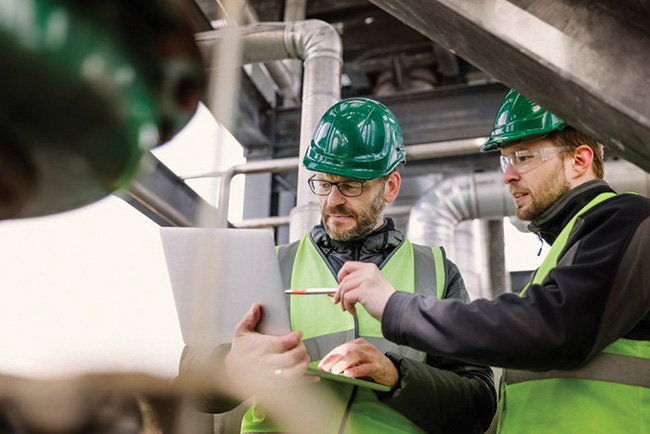Seven fundamental facts and practical tips for establishing a positive safety culture.
By Natalie Connell
Waste and recycling is the seventh most dangerous industry in the U.S., according to the Bureau of Labor Statistics. Backing alone accounts for 25 percent of all injuries and accidents. To protect employees, every company must stop and consider their safety culture. But what exactly does this rather abstract term mean? What does a safety culture assessment look like? And how can companies work to establish a positive safety culture? This article will outline the key facts about safety culture in the waste and recycling industry.
Definition: What is a Safety Culture?
Your company’s safety culture, also known as health and safety culture, is the sum of its employees’ combined attitudes, beliefs, perceptions, views, and values in relation to every aspect of occupational health and safety (OHS). It determines the priority assigned to OHS and how employees perceive and practice safety in their day-to-day work. The more positive a company’s safety culture, the more its employees will think ahead and adopt safe behaviors.

Fact #1: Every Company Has a Safety Culture
The question of whether your company has a safety culture is not decisive—because safety culture is characterized by everything that happens (or does not happen) in relation to occupational health and safety. In other words, every company has a safety culture of some sort. It may well be negative, i.e., rudimentary, suffer from a lack of management responsibility or be impaired by ignorance among the wider workforces.
Only a positive safety culture will enable your company to progress. It will protect your employees, ensure safety specialists and managers are able to act, and boost motivation. Consider that trash collection is one of the most dangerous jobs in the recycling industry. Worker fatalities occur due to being struck by oncoming vehicles and crushing by rear-loading trash trucks. Establishing a positive safety culture is not only key to preventing accidents, but also in reducing lost time, and minimizing production losses and process interruptions.
Fact #2: Your Safety Culture Improvement Action Plan is Developed Step-by-Step
Think back on your school days. Did you progress straight from first grade to college? Of course not. It would not have been productive in any way and would only have hindered you. When it comes to establishing a positive safety culture, assessing the current situation in your company is a decisive first step. You can then implement measures to help you reach the next step (rather than skipping ahead). One established safety culture model within the waste and recycling industry is the Bradley Curve. It helps define the status quo in organizations and improve their safety culture. The Bradley curve depicts four stages of safety culture. A company’s culture can be attributed to any one of these stages and be developed to reach others. Companies in which accidents occur frequently are in the first stage (negative safety culture). At the other end of the spectrum, in the fourth stage, are companies in which accidents are rare or do not occur at all (positive safety culture). Between the first and fourth stages are two interim stages. Each stage is characterized by a behavioral basis in relation to occupational health and safety. This is based on a key question: What is the foundation to prevent accidents—natural instincts, rules and supervision, responsibility, or shared responsibility?
Fact #3: Managers Play a Crucial Role
One of the most important guarantees of success in founding a positive safety culture is having role models. Above all, managers must be aware of their responsibility and fulfill this role every single day. Only then can an effective safety culture take root and spread among employees. The management’s commitment to the safety culture must be clear for everyone in the company to see. However, this goes further than simply serving as a role model. A clear commitment to safety culture also includes actively engaging in safety-related conversations, OSH campaigns, participating in audits, and investing in occupational health and safety.

Photos courtesy of AMCS.
Exert Your Influence
Managers hoping to push a successful transition from unsafe to safe behaviors need expert insights into psychological and practical aspects. It is critical to get people motivated about occupational health and safety and how you can influence this process by intervening at the right point in the safety loop (thought-reaction-
experience-mindset).
Fact #4: Getting People Involved is the Ultimate Goal
Imagine you have been invited to attend a talk. Turning up and listening to the speaker is no big deal. But, if we are honest, a lot of the content might go in one ear and out the other. However, preparing this talk and presenting it yourself is an entirely different proposition. The same principle applies when establishing a positive safety culture. Employees need to be actively integrated in safety-related tasks, such as drawing up safety rules and standards and planning and conducting safety inspections and audits.
Fact #5: Less is More: Positive Safety Culture Relies On Streamlined Processes
Making sure you do not overburden your employees is essential. There is no sense in producing hundreds of regulations and initiatives, adding more and more each week like a magician pulling rabbits from a hat. Instead, safety-related measures need to be straightforward, targeted, and easy to understand. The same goes for individual processes. They need to be adapted to specific sites’ rules and statutory safety standards and provide coherent, standardized instructions. This makes the topic of safety easy to understand and effortless to internalize.
In addition to employees, however, safety specialists and OSH managers also need support and assistance to implement modern occupational health and safety. Once a company grows beyond a certain size, the only way for safety professionals to work efficiently is with specialist software support.
EHS software simplifies these traditional occupational safety processes, by automating incident management and automatically updating legal registers and safety data sheets. For example, workers at metal recycling companies face potential health problems from exposure to hazardous chemicals. Instant access to crucial safety information ensures that workers are aware of the risks associated with specific chemicals.
A software solution can clearly display all occupational health and safety activities, such as cycling the compactor only when the dumpster is on the ground and linking them to the people responsible—from employees, managers, and specialist staff, to auditors or executives. In addition, they can often generate evaluations and reports in just a few clicks.
Fact #6: Without Targets, There Can Be No Measurable Success
People often say that the journey is the reward. There might certainly be something in that. However, if you do not define exactly where the journey is going, you risk simply standing still. Setting clear targets is, therefore, one of the most vital instruments when establishing a robust, resilient safety culture. To begin with, a company could aim to reduce the number of accidents by a given percentage. After that, the company can set more modern targets, like increasing incident reports, the number of safe behaviors, or safety-related meetings.
Other potential targets include reducing psychological stress—a very real dilemma within the industry—improving ergonomic working, reducing noise exposure, optimizing occupational safety-related communication, achieving a more positive perception of occupational health and safety, or increasing employee participation in safety processes.
Whatever targets a company sets for itself, adopting a systematic approach is essential. It enables the company to trace progress with vigor and, ultimately, achieve its targets. First, safety managers cast light on the relevant processes and record, document, and analyze incidents that occur. Based on this data, the company can then formulate clear targets and derive appropriate measures. Once this process has been established as a fixed part of its safety culture, the company can take another step forward.
Fact #7: What are the Benefits of a Positive Safety Culture?
A positive safety culture will provide numerous benefits for your company, and especially for workers during collections or working with heavy machinery, including:
Enhanced protection for employees
A healthy, motivated workforce
Improved team spirit
Quantifiably fewer accidents
Reduction in injury-related lost time
Protection for systems and machines
Lower production losses
Fewer process breakdowns
Improved procedures
Higher efficiency and productivity
How to Create Safety Culture in the Workplace
A positive safety culture is the heart and soul of successful occupational health and safety. It is a crucial part of ensuring employees are continuously encouraged to behave safely and avoid accidents. Developing a safety culture is a journey that progresses step-by-step. Safety managers have numerous instruments at their disposal to use at different stages on the Bradley Curve. By applying a combination of these instruments and adopting a gradual, systematic approach, you can drive your safety culture forward—and drive your company toward success. | WA
Natalie Connell is Marketing Director for AMCS Group. She can be reached at [email protected].
References
www.bls.gov/news.release/pdf/cfoi.pdf
https://swana.org/resources/safety-resources
www.quentic.com/articles/using-the-bradley-curve/
www.quentic.com/articles/prof-christoph-boerdlein-about-behavior-based-safety/
www.quentic.com
